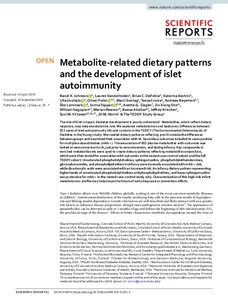Metabolite-related dietary patterns and the development of islet autoimmunity
Randi K. Johnson; Lauren Vanderlinden; Brian C . DeFelice; Katerina Kechris; Ulla Uusitalo; Oliver Fiehn; Marci Sontag; Tessa Crume; Andreas Beyerlein; Åke Lernmark; Jorma Toppari; Anette-G. Ziegler; Jin-Xiong She; William Hagopian; Marian Rewers; Beena Akolkar; Jeffrey Krischer; Suvi M. Virtanen; Jill M. Norris; & The TEDDY Study Group
Metabolite-related dietary patterns and the development of islet autoimmunity
Randi K. Johnson
Lauren Vanderlinden
Brian C . DeFelice
Katerina Kechris
Ulla Uusitalo
Oliver Fiehn
Marci Sontag
Tessa Crume
Andreas Beyerlein
Åke Lernmark
Jorma Toppari
Anette-G. Ziegler
Jin-Xiong She
William Hagopian
Marian Rewers
Beena Akolkar
Jeffrey Krischer
Suvi M. Virtanen
Jill M. Norris
& The TEDDY Study Group
NATURE PUBLISHING GROUP
Julkaisun pysyvä osoite on:
https://urn.fi/URN:NBN:fi-fe2021042822710
https://urn.fi/URN:NBN:fi-fe2021042822710
Tiivistelmä
The role of diet in type 1 diabetes development is poorly understood. Metabolites, which reflect dietary response, may help elucidate this role. We explored metabolomics and lipidomics differences between 352 cases of islet autoimmunity (IA) and controls in the TEDDY (The Environmental Determinants of Diabetes in theYoung) study. We created dietary patterns reflecting pre-IA metabolite differences between groups and examined their association with IA. Secondary outcomes included IA cases positive for multiple autoantibodies (mAb+). The association of 853 plasma metabolites with outcomes was tested at seroconversion to IA, just prior to seroconversion, and during infancy. Key compounds in enriched metabolite sets were used to create dietary patterns reflecting metabolite composition, which were then tested for association with outcomes in the nested case-control subset and the full TEDDY cohort. Unsaturated phosphatidylcholines, sphingomyelins, phosphatidylethanolamines, glucosylceramides, and phospholipid ethers in infancy were inversely associated with mAb+ risk, while dicarboxylic acids were associated with an increased risk. An infancy dietary pattern representing higher levels of unsaturated phosphatidylcholines and phospholipid ethers, and lower sphingomyelins was protective for mAb+ in the nested case-control study only. Characterization of this high-risk infant metabolomics profile may help shape the future of early diagnosis or prevention efforts.
Kokoelmat
- Rinnakkaistallenteet [27094]
